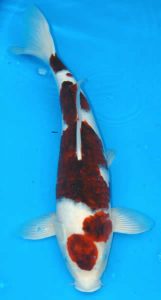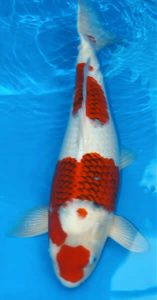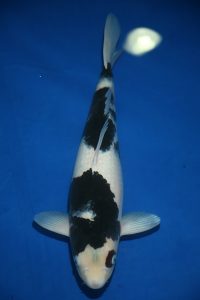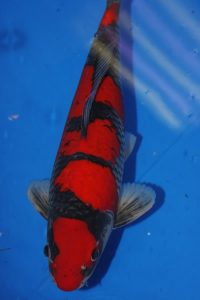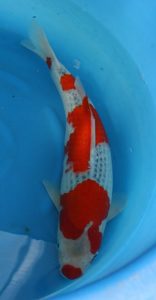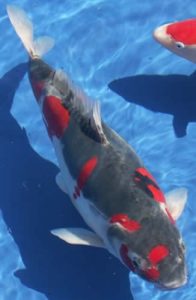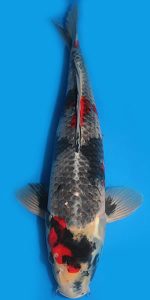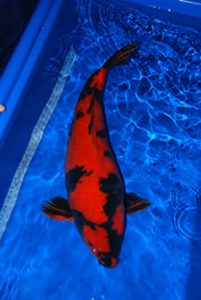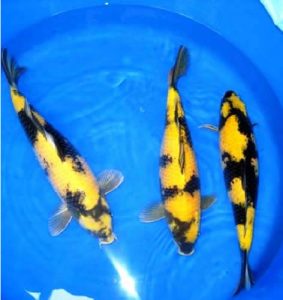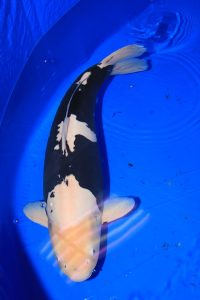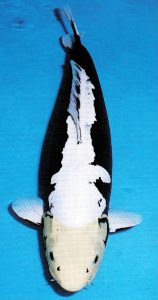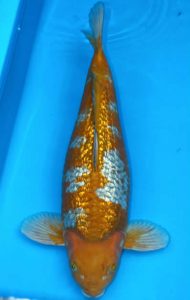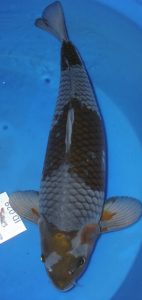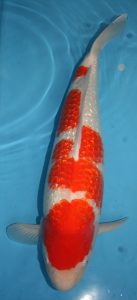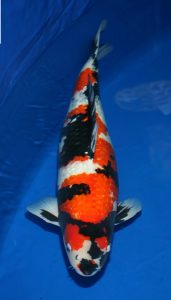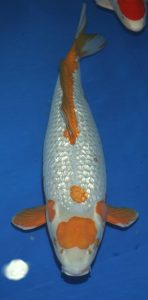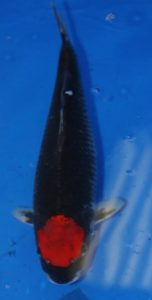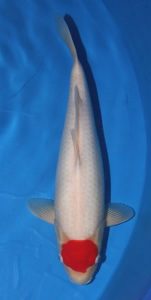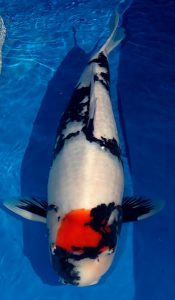Author Archives: Charlene Cebulski
Goromo – An Amazing Breed by Bryan Bateman
Of all the beautiful varieties of koi that have been developed over the years, to me the Ai Goromo takes the prize as the most amazing accomplishment by the breeders of Japan. Ai Goromo is easily recognized by the delicate blue edging, or reticulation, on each red scale on a pattern of what would otherwise be a kohaku. Its cousin, the Goshiki, is an interesting contrast with its typical blue edging on the white. These two varieties are frequently combined as a single variety for koi show purposes.
Two sub-types of Goromo, Sumi Goromo and Budo Goromo, are not as elegant or refined in appearance, and consequently don’t generally compete very well in shows against a good Ai Goromo. Sumi Goromo has a much darker and heavier edging, and the Budo Goromo has “grape clusters” (translation of “Budo”) mixed in with the normal reticulation. These two sub-types can sometimes be mistaken as shiro utsuri (black and white koi) due to the dark ai (blue) almost completely covering the red, but if you look closely you will see the red appear as a dark purple thru the almost black pattern.
Ai Goromo was probably developed by crossing an Asagi with a Kohaku. As a result of this cross, the Ai Goromo inherited a striking bluish-white background from its Asagi parent.
When selecting a young Ai Goromo, look for one with an attractive kohaku pattern and with reticulation that is barely visible if at all. This is why this variety is such a challenge to collect. You must be sure of the parentage, and even then there can be no guarantee that the reticulation will come, or that it will be even. The reticulation tends to darken and thicken with age, so if you buy a young (one or two years old) Goromo that appears to be a nearly finished Ai Goromo, the chance is very good that it will darken and become either a Budo or a Sumi Goromo. If, on the other hand, you are lucky enough to find one that develops into this most rare beauty, with each red scale outlined in a thin crescent-moon of blue, it will take your breath away. Happy hunting!
© Bryan Bateman 2009
Goshiki – “five-colored” by Bryan Bateman
I have always been fascinated with the Goshiki variety, with its many variations of color, reticulation and pattern. Recently goshiki have been divided into two sub-types: Light, or mameshibori (also sometimes called kindai) goshiki, and dark, or kuro goshiki.
The light version looks much like a kohaku but with thin crescent-shaped dark blue reticulation appearing on the white skin, whereas the darker kuro goshiki sometimes has reticulation on the red as well, with the white area becoming almost completely dominated by heavy dark blue reticulation – appearing almost like black or dark purple rather than white.
The original meaning of goshiki is “five-colored”. These colors are white, black, red, light blue, and dark blue. When mixed on some goshiki (i.e. kuro) the ground (main, or background color of the body) can appear as purple, which makes for a really cool looking fish!
This variety was originally placed in the kawarimono (or “miscellaneous”) class for judging purposes, but due to great efforts to improve and refine the variety, it was recently upgraded to a combined koromo/goshiki class.
The reason these two varieties are combined into one class is that they are of the same genetic blend – kohaku and Asagi. The kohaku gene contributes the red patterning on a white background while the Asagi gene contributes the reticulation. In the case of koromo this reticulation is restricted to the red areas, while with goshiki the reticulation is usually restricted to the white areas (the exception being kuro goshiki as mentioned above which sometimes has reticulation on both the red and white areas).
Two popular variations of goshiki are goshiki sanke ( aka goshiki sanshoku) and goshiki showa. These will appear as normal goshiki with added small black patches in the case of goshiki sanke or with added larger black wrapping markings in the case of goshiki showa. Both of these types are placed in the kawarimono class for judging purposes.
When selecting a young goshiki for your collection you should first look for a pleasing kohaku pattern. Sandan (three-step) is ideal on a goshiki because it provides for a large amount of white area to accentuate the reticulation. Judges are a bit more lenient regarding the placement of the red on the head of a goshiki. For example, a goshiki with either too much or not enough red between the tip of the nose and the eyes will be acceptable as long as the red is bright and clean and the white provides a pleasing background, giving the koi an artistic look.
The fins should be either all white or can have red at the base (moto aka). The reticulation should be even (not irregular or splotchy appearing) and the red should appear almost to be floating on the ground – a unique characteristic of high quality goshiki. Young goshiki will often appear to be kohaku, as the reticulation normally does not appear until later. You have to trust your dealer in this respect, who should know the lineage of the fish he is selling.
Whether you fancy the kuro goshiki or the elusive ( ‘been looking for one for years!) mameshibori goshiki, this variety will certainly delight and will be a big attraction in your pond.
© Bryan Bateman 2009
Utsuri – Shadow and Light by Bryan Bateman
Shiro Utsuri (pronounced SHE-row oot-SOO-ree) is a member of the Utsuri class at koi shows, which also includes Ki Utsuri (yellow and black), and Hi Utsuri (red and black). Of these three, the Shiro Utsuri, or white and black koi, is by far the most popular, and will often compete with Gosanke – Kohaku, Sanke, and Showa – for Grand Champion at koi shows.
“Utsuri” translates from the Japanese as “reflection”, which refers to a tendency these koi have of displaying alternating markings, much like a checkerboard, on their bodies. Modern patterns vary, however, from the traditional checkerboard type to a limitless array of artistic interpretations. We see banded “bumble-bee” patterns, or we may see continuous “inazuma” or lightning type patterns that run to and fro over the entire koi from head to tail, or maybe a koi with just a few brush-mark splashes of sumi seeming to float on a sea of white.
A similar variety often confused with Shiro Utsuri is Shiro Bekko, which is also a black and white koi. The difference between these two types lies in the location and shape of the black markings. While Utsuri normally exhibit larger, wrapping black markings, which will often appear on the head as well as on the body, Bekko are distinguished by the small stepping-stone type of markings appearing on the body but not on the head, much like we see on Sanke.
The ratio of black to white on a Shiro Utsuri is largely a matter of personal preference, but in koi shows, a Shiro exhibiting a greater proportion of white to black will generally fare better.
Other appreciation points are that the pectoral fins should have moto guro, or black patches, at the base of each fin, and that the other fins should be all or mostly white.
The black pattern should have an artistic balance that is pleasing to the eye, with not too much front vs back or side vs. side, and there should be some black on the head region – preferably forming an eye-catching complement to the overall pattern. This contrast of black and white, with no other colors, creates a beautiful and intriguing fish which will complement any koi pond.
© Bryan Bateman 2009
Kumonryu – The mysterious ever-changing koi by Bryan Bateman
One of the most interesting varieties from a developmental standpoint is the black and white, scale-less Kumonryu. It comes from a long line of koi beginning with a dark-colored magoi variant called a Tetsu Magoi. From crosses with this koi many years ago an all black koi was developed called a Karasu (crow).
Some of these koi had white fin tips, which were singled out and further cross-bred to create koi with more and more white. Eventually a black koi with a white head and white fins was developed called a Yatsushiro.
The first kumonryu, which is merely a doitsu (scaleless) version of a yatsushiro, was created when a shusui (doitsu koi with red lateral markings and a bluish body color) was crossed with a yatsushiro.
One way to tell a kumonryu from a doitsu shiro utsuri (also a black and white scaleless koi) is to look closely at the white skin. A kumonryu will have a bluish tint, inherited from its shusui parent.
The other difference between the two is the genetic tendency of the sumi (black) to appear as a wrapping pattern on Utsuri, while it appears more as a lateral-type pattern (running lengthwise) on Kumonryu.
From the first kumonryu many breeders have developed variations in the patterning, including some truly spectacular specimens reminiscent of a killer-whale type of pattern. The problem is, these koi have a nasty habit of changing colors from season to season (black becomes white and white becomes black!) and also changing their patterns from year to year, so that you may not even recognize your own koi if you don’t watch it closely!
For this reason, it is difficult to select a baby kumonryu. They tend to develop more black as they mature, so some hobbyists recommend purchasing predominantly white babies. If you really want to increase your chances of getting a good specimen, and your budget and pond can handle it, perhaps purchasing two or three of them would make sense. These koi are a lot of fun to own and provide endless fascination as they change their patterns from season to season and from year to year.
© Bryan Bateman 2009
Ochiba Shigure – Autumn Leaves on Water by Bryan Bateman
Have you ever seen a soft gray colored koi with gold patterning? If you have, you likely would not forget, because it is very different looking than the brightly colored koi we are used to seeing. This quietly refined and elegant koi is called an Ochiba Shigure, which aptly translates to “autumn leaves on water”. The delicately reticulated scales do indeed give an impression of leaves floating on a calm pond, with the golden-leaved trees reflected on the surface.
A relative newcomer on the koi scene, having been around only since about the mid-90s, the Ochiba is actually a cross between a gray Soragoi and a golden brown chagoi. These two ancestors have a reputation of being the friendliest of koi, and the Ochiba has happily inherited that trait. Many hobbyists will have one of these types koi in their collection for the purpose of encouraging other, shyer koi to “come out of their shells” and be more sociable. They will be the first to come up to greet you as you approach your pond, and will readily eat from your hand.
For show purposes, they are usually grouped with the “kawarimono” class, which is a catch-all for many of the lesser-known varieties. However, due to their increasing popularity, some shows have a special award for best Ochiba. There are many newer types of Ochiba as well, including a scale-less Doitsu Ochiba, a sparkling ginrin Ochiba, and most recently a metallic doitsu ochiba. Another sub-variety has been a cross between a red and white Kohaku and an Ochiba, giving an attractive gray and red patterned koi.
If you want a friendly new addition to your pond, and you enjoy the understated softness of earth tones that remind one of the colors of fall, Ochiba Shigure might be your koi.
© Bryan Bateman 2009
Ginrin – Diamonds by Bryan Bateman
Many of us when new to the koi hobby are attracted by those “sparkly” little koi that seem to be covered with diamonds. These are known as “ginrin” koi. GinRin is not a variety per se, but a characteristic that can be seen on any scaled koi. The Japanese pronunciation sounds like “geenleen”, but it has been Americanized by most to sound just like it looks, with a hard ‘G’. It translates to “silver scale”, and is sometimes referred to as “KinGinRin”, or “Gold and silver scale”. This is because, when ginrin appears on a red fish such as a kohaku, it sometimes has a gold appearance. This silver effect is due to the presence in the scale of a chromatophore called guanine, which was first noticed in a random spawning in Japan in 1929.
There are actually four distinct types of GinRin scales. The most common is known as “diamond gin”, and appears much like cracked glass over the entire scale. A highly valued type, and hard to find in this country, is called “Beta Gin”, which is characterized by the entire scale being covered with silver, much like a mirror. A third type is “kada gin”, or “edge gin”, which is exactly as it sounds – each scale is edged in silver. The last, and by far rarest, is pearl gin. On this type, the gin appears only in the center of the scale, and truly looks as though someone carefully mounted a diamond on each scale.
When selecting a young ginrin koi, look for those with at least three rows of ginrin scales on either side of the dorsal fin. These scales should be evenly lined up in neat rows and of consistent shine. I can remember when I was new to the hobby and looking at a young ginrin with jumbled ginrin scales. The dealer told me not to worry, that they will line up as the fish grows. Didn’t happen, and never will!
Appreciation of ginrin can be a very personal and subjective point. Some hobbyists feel that it is a distraction, particularly in patterned koi. It can certainly be a beautiful enhancement to one-colored koi such as cha-goi and yamabuki ogon. Whatever your preferences, any collection will benefit from the presence of one or more of these “living jewels.”
© Bryan Bateman 2012
Tancho – The Crane by Bryan Bateman
A tancho is any koi with red located only on the head. If it has red anywhere on the body other than the head, it is no longer considered a tancho. Named for the Tancho Crane, and very popular in Japan due to the similarity of this type of marking to the Japanese flag, tanchos have their own class in koi shows. This class generally includes tancho kohaku, tancho sanke, and tancho showa, but may include other types of tancho as well, such as tancho goshiki, tancho beni kumonryu, or tancho ochiba. The inclusion of these other types of tancho is determined by each club and show chairman.
The tancho marking may have many shapes, however a round shape is considered ideal. The size of this mark should be as large as possible without going past the eyes, back onto the beginning of the scales, or too far forward on the forehead, and it should be centered. Other shapes sometimes seen are square, cross-shaped, or irregular flowery-type shapes. Any of these are acceptable on a tancho as long as they are uniformly shaped, are centered on the head, and have a pleasing look to the eye.
Purchasing a young tancho can be risky as they frequently will lose the tancho mark as they mature. It is best to buy them at two or three years of age, as the mark will generally be stable by this time. You want to look for a tancho marking that appears thick, with no windows or light areas, and with clean, sharp edges. In the case of tancho sanke or tancho showa, look for a pleasing, well-balanced sumi (black) placement to complement the red marking. My favorite is tancho showa, especially the ones with black partially covering the tancho mark – giving the appearance of clouds passing in front of a full harvest moon.
© Bryan Bateman 2012
Yamabuki Ogon by Bryan Bateman
|
Yamabuki Ogon
 |
The history of the development of metallic koi is an interesting one. About 90 years ago, a Japanese hobbyist by the name of Sawata Aoki had a dream to create a special type of koi. When he heard that a young boy had found a wild carp in a river which had golden stripes on it, he walked many miles to see this carp, and convinced the boy to sell it to him. He carried his new treasure home and spent the next 25 years patiently breeding and selecting the brightest and shiniest offspring until, in 1946, he finally achieved his dream – the first metallic koi. This koi soon came to be called a Yamabuki Ogon, and is the original ancestor of all metallic koi that we have available to us today.
Today Yamabuki Ogons are one of the most popular of varieties. Although extremely expensive when first made available to Japanese collectors, they can now be had at prices well within the budget of most hobbyists. They are hardy, grow quite large, and are generally the friendliest of koi. Their bright shiny yellow color will attract your eye especially as the sun strikes them.
© Bryan Bateman 2014 |
The Elusive Beni Kujaku by Bryan Bateman
One of the more interesting and attractive developments in recent years has been the modification and improvement of a popular variety known as the Kujaku (“peacock” in Japanese) The first Kujaku was created in 1960 by crossing a matsuba ogon and a hariwaki. The result was a metallic koi with reticulated scales and a pattern of yellow, orange, or various shades of red on a white background. The Kujaku became an instant hit with collectors. For show purposes, Kujaku is placed in the Hikarimoyo class, competing against other patterned metallics including hariwaki, kikusui, yamatonishiki (metallic sanke), and metallic bekko. Due to the added refinement of the reticulated scales, the Kujaku has a definite advantage over the other members of this class, and is most often selected as “best in class” for hikarimoyo.
Occasionally a Kujaku would be seen with a deep rich red pattern, but it was a rarity as the hariwaki lineage most often results in yellow to orange shades. Recognizing a demand for the red (beni) Kujaku, breeders embarked on the goal of developing a Kujaku with consistently red coloration. A breeder in Niigata, Japan, by the name of Koneko, became the first to achieve this. He reputedly crossed a traditional Kujaku with either a metallic Kohaku or a red Kikusui, and the result has been a new line of beni Kujaku which have become the standard of the breed.
When selecting a young Kujaku for your collection, look for a koi with excellent metallic sheen. Also, check for even, sharp reticulation on all scales. On a tosai (one-year-old koi) this reticulation may not be “up”, so if you are not sure of the breeder it may be best to purchase Kujaku at two years old, when the reticulation is more likely to be developed. The head should be clean and white with no smudging or black markings, and the fins should be a lustrous silvery color. As always, look for a healthy koi that appears to be curious and actively swimming with its tank mates. The pattern on a Kujaku should resemble that of a Kohaku. In other words, pleasing to the eye and balanced from head to tail and side to side. A simple two or three-step pattern seems to work very well with the reticulation. A busy pattern can look too chaotic when coupled with the reticulation.
It can be a challenge finding the “right” Kujaku for your tastes, but when you finally find that elusive red Kujaku, you should consider adding it to your collection.
© Bryan Bateman 2014
THE INS AND OUTS OF KOI POND BUILDING by Mike White, White Water Filters PART 1: Planning
PART 1: Planning
Are you thinking about building or having a koi pond built? In this series of articles I will discuss how to build a koi pond. Why is it important for you to read this article prior to “digging in”? Because quite frankly there are many people in the pond industry that are telling people things that are not true, just to sell their products. Or, they installed a system themselves and feel it is the best.
Why should you take the time to read what I have to say? I have been involved with the koi hobby for over 25 years. I see more than 100 different ponds every year. I sell, install and maintain many different types of pond and koi products. I have worked with both old technology and cutting edge technology. I have written articles for various pond related publications and have conducted seminars. And I will be the first to tell you that there is no such thing as a “perfect” system.
What make a koi pond different from any other pond? The first thing is that this is a pond designed to house large fish, a type of carp, koi. In a large area they can easily be raised to a size in excess of two feet long and may grow to 3 feet long. That is a big fish. A fish this size needs room to swim and grow. But an even larger concern is that this fish uses very little of what it eats. More than 90% of the fish’s intake is expelled as waste.
A koi pond seldom has many plants in it as larger koi will eat almost any plants that grow on or below the water’s surface.
Koi are often costly and because of their bright colors, koi are susceptible to predators. In this area the primary predator of koi is heron, but raccoons can also present a problem. In addition, some times the design of the pond can cause damage to these “living jewels”.
Before you build your pond there are a lot of decisions that need to be made. Your first decision is what are you going to keep in your pond. Since you are building a koi pond, that decision has been made.
Next, you should determine the size and location of the pond. Let me give you a few pointers on this topic. First, water will naturally draw people to that area of your yard. By this I mean that if you don’t build it near your outdoor living area you will end up with a new outdoor living area – near the pond. Secondly, it should be close to and easily observed from your house. I guarantee that even while in your house you will look out to see the pond all the time. The closer, the better!
As for size, most people will tell you that you can’t make it too large. That isn’t necessarily true. If it is too large, it will be hard to see the fish or catch them when necessary. Your pond should be built so that all areas of the pond are within reach of a koi net extended to no more than fourteen feet. What this means is that you should be able to walk down one side of the pond or across a bridge and be able to reach every area of the pond. If you can’t do this, it means that you will have to use a seine net or have a helper every time you want to catch a fish in the pond. Yes, I know there are experienced pond keepers who break this design rule and can catch the fish. But it takes a great deal of experience to be able to do this. Or you are going to say, I don’t plan on having to catch any fish but that view is unrealistic.
If at all possible, the pond should not be in direct sunlight all day. Ideally, no more than four to six hours of direct sunlight should be on your pond during the summer. In the best arrangement, shade should be provided by a building or structure, but this isn’t always possible. If trees provide your shade, there will be a problem of debris from the trees getting into the pond. If it is not possible to avoid this situation, don’t worry about it. I am talking about ideal circumstances. I am always going to present the ideal ponds, but in building a pond there are always trade-offs from the ideal.
In future issues I will discuss pond design, skimmers, bottom drains, pumps, filtration, ultra-violet lights, ozone, aeration, plumbing and other pond equipment. Not everyone can build their ideal pond at the outset so I will also talk about pond building in stages based upon budgets.
©2004 all rights reserved to Mike White

